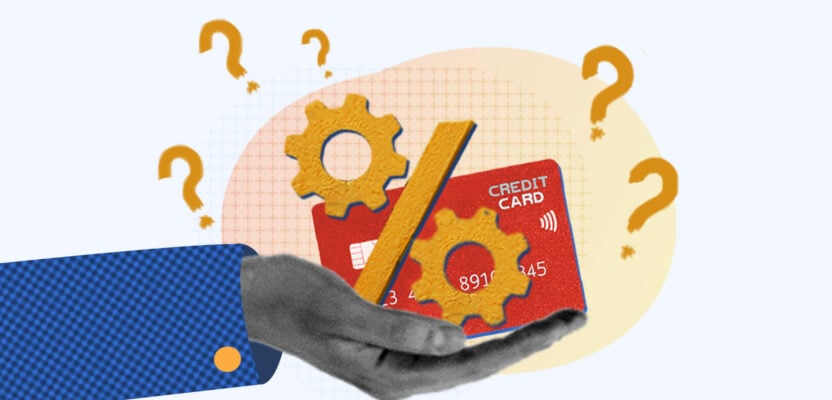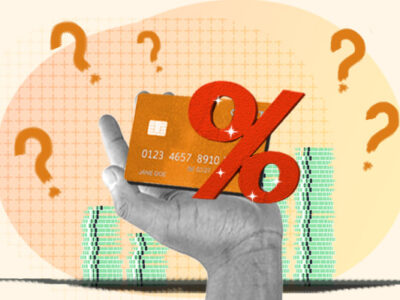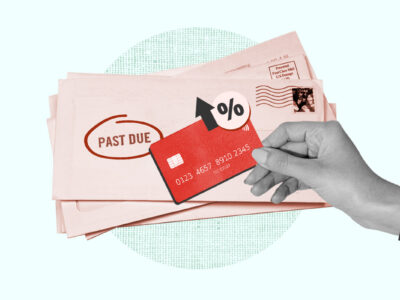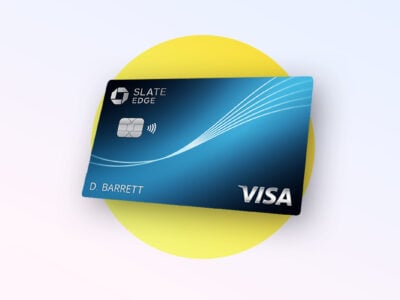Like other types of loans, credit cards have interest rates. But how exactly does credit card interest work? We’ll walk you through what credit card interest is, how it’s determined, how to calculate interest charges, and ways you can pay less interest on your monthly credit card bill.
Table of Contents
What is a credit card interest rate?
If you’re credit card hunting and can’t figure out where the interest rate is stated, it’s because the average credit card interest rate is listed as credit card APR rather than the monthly or daily rate.
APR stands for annual percentage rate. It’s the yearly cost of borrowing money on a credit card. This rate varies between cards, and the rate you get often depends on your credit score.
Although APR is an annual rate, credit card interest is charged on a monthly basis. In most cases, you won’t have to pay interest as long as you pay off your balance in full before the due date every month. 1
How do card issuers determine interest rates?
Card issuers determine interest rates based on the card type and the borrower’s creditworthiness. For example, credit cards for borrowers with bad credit are more likely to have high interest rates.
As a general rule, people with good credit scores can qualify for cards with lower interest rates, whereas people with bad credit scores get higher interest rates.
How to calculate your interest charges
Credit card interest is complicated, and many borrowers find themselves surprised and confused at their credit card statement each month.
You can follow these 4 steps to calculate your interest charges (note that these numbers are approximate and used as examples only):
Step 1: Calculate your credit card’s daily periodic rate
Divide your credit card’s APR by the number of days in the year (365). You can find your current APR in your credit card statement or online account. 2
For instance, if your APR is 18%, then your daily periodic rate is:
Step 2: Calculate your average daily balance
Once you have your daily periodic rate, you’ll need to determine your average daily balance. Your interest is calculated each day, so you need to know the average amount that you owed on each day of your billing cycle.
Your credit card statement only shows your individual charges for each day and not your total balances, so this step will take a bit of manual calculation. Just look up what you spent on each day of your cycle, add those numbers up, and divide the amount by the number of days in your billing cycle.
Example of a daily balance calculation
To make this a bit simpler, we’ll go over an example. Let’s say you started the billing cycle with a balance of $150. On Day 7, you made a purchase of $50. Then, on Day 24, you made another purchase of $100.
If your billing cycle is 30 days long, this is what your daily balance for each day would look like:
- Days 1-6 (6 days): $150
- Days 7-23 (18 days): $200 (original $150 balance + the new $50 purchase)
- Days 24-30 (7 days): $300 (original $200 balance + the new $100 purchase)
Now that you have the amounts of your daily balances, add them up. Then, divide that figure by the number of days in your billing cycle. Doing so will give you your average daily balance.
Here’s a demonstration of the calculation:
As you can see, $220 is your average daily balance.
Calculating your average daily balance is arguably the most difficult part of this process. The next two steps are relatively easy.
Step 3: Multiply your daily periodic rate by your average daily balance
Here, simply multiply your daily periodic rate from step 1 (e.g., 0.00049) by your average daily balance from Step 2 ($220).
In our example, this works out to:
Step 4: Multiply the number from step 3 by the number of days in your billing cycle
This step shows you the approximate amount of your interest. Remember that we set your billing cycle as 30 days in step 2.
So here’s what the calculation will look like:
That’s approximately how much interest you’ll have to pay (unless you pay your balance before your payment due date, in which case your interest charges will be waived).
Credit card companies perform a more complicated calculation
The calculation above will yield approximately how much interest you have to pay, but because it works off of averages, it’s not exact.
Most credit card companies will take it a step further and multiply the average balance you have every day by the daily periodic rate of your account, then add that figure to the following day’s average daily balance. 3 In other words, they’ll actually calculate your interest each day.
This act of daily compounding can be very complicated and time-consuming to do manually. The good news is, you don’t need to do it yourself—there’ll only be a small difference between your exact interest charge and the approximation you’ll get by performing the calculation we walked you through above. 3
When is interest charged?
Interest is charged on what’s known as your revolving balance. When you don’t pay your entire balance before the payment due date, the unpaid portion that carries over to the next month is your revolving balance.
So if you pay your balance in full each month, your credit card bill will never be charged interest.
Do you pay APR every month?
Again, you don’t ever have to pay APR as long as you pay your credit card in full and on time every month.
However, if any balance remains on your monthly statement, then yes, you will need to pay interest (APR) every month.
Other forms of credit card interest
Credit card interest doesn’t only apply to purchases. In fact, there are many types of credit card APR which apply to different types of transactions.
To make the best use of your credit card (or find the right new card with the terms you want), you should know the following types of credit card APR:
- Purchase APR: This interest rate applies when you make new purchases and carry a balance on your credit card into the next billing cycle. It’s the most common type of APR you’ll see on credit cards.
- Balance transfer APR: This interest rate applies to the balance you transfer from one credit card to another. Balance transfers are often made as a form of debt consolidation.
- Cash advance APR: A cash advance is when you use your credit card to withdraw money from an ATM. Cash advance APR tends to be higher than purchase APR, as cash advances are essentially short-term, high-interest loans.
- Introductory APR: Intro APR is a temporary, promotional APR that’s lower than the card’s regular rate. Some credit card companies offer a 0% APR on purchases or transfers for a period of time to customers as an incentive to open a card. For example, many cards have 0% intro APR for the first year of card ownership.
- Penalty APR: The penalty APR applies to your account when you miss payments or violate any of your card’s terms. It’s one of the highest APRs on your credit card, as an incentive to make timely minimum payments. 4
Ways to avoid or reduce credit card interest
Here are 5 ways to minimize or avoid interest charges on your credit card:
- Pay your bills in full each month: If possible, pay your bills in full to avoid paying interest at all. This also means you never have to worry about forgetting to make a payment and getting hit with late fees.
- If you can’t pay in full, pay more than the minimum: If you’re unable to pay your balance in full, don’t be content with just making your minimum monthly payment—try to pay your balance down as much as you can. The lower your balance is, the less you’ll have to pay in interest. 5
- Negotiate a lower APR: There’s no guarantee this will work, but you can call your credit card issuer and negotiate a lower interest rate if you’re struggling to pay your bill in full each month. Securing a good credit card APR could make a big difference on your credit card statement each month.
- Use a credit card with a 0% introductory APR: Credit cards with a 0% intro APR allow you to save money on interest for up to 21 months, depending on the card. Keep in mind that this promotional 0% APR period is only temporary, so you should take note of when it ends.
Check out our top picks for the best 0% APR credit cards.






